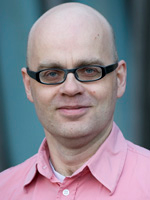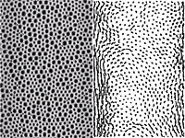
Understanding the game of marbles
Not many scientists can claim to have received funding from NWO to blow bubbles and play with sand, but Martin van Hecke definitely can. Van Hecke, Professor of the Organisation of Disordered Matter, delivered his inaugural lecture on Friday 4 September, under the enigmatic title of: ‘Bellen, bollen, ballen’ (that translates roughly to: Bubbles, Grains and Balls).
Unpredictable physics
Van Hecke studies grains of sand and rice, foam bubbles and marbles, combining the best of two worlds: the sand pit and most unfathomable and unpredictable world of physics. A simple container of sand or soapsuds has a complexity and unpredictability that almost match those of the weather. And the advantage for Van Hecke is that, unlike a weather expert, he can experiment with his material. It is easy for him to observe the complex behaviour of sand and foam, which is more difficult in a supercoductor. He can even make pictures of their behaviour.
Simple grains of sand

This complex interplay of apparently simply physical systems fascinates Van Hecke. 'How is it possible that when you have a lot of simple grains of sand together, they can form pirouetting peaks?' We understand the rules, says Van Hecke. These are the simple laws of nature described by Newton and his colleagues. 'We can describe simple systems, such as power balls, but if we have a thousand power balls jumping around on a vibrating plate and colliding, the system becomes more complex, and that's when it really gets interesting. 'You have to do new things to understand disordered materials, and then you make new discoveries.'
Chaos theory
For the time being, his materials are mainly 'nots': 'They are not linear, not ordered, and above all not balanced. Originally, Van Hecke came into contact with this world of 'nots' through his study of chaos theory, a field that he has since left behind.
Mixtures
His materials are often mixtures: of glass and liquid (foam), or liquid and solid (mud). A promising way of looking at the behaviour of these complex materials is to study the analogy with the well-known phenomenom of phase transitions in physics: between gases, liquids and solid materials.
The power of a single grain of sand

In his inaugural lecture - which includes a number of short films - Van Hecke shows his audience the amazing collective behaviour of his 'particles'. He introduces them to the memory of sand, the power of a single grain of sand and the force networks in foam.
Computer simulations
He also explains about the enormous importance of computer simulations, and about his expectation that computer simulations and experiments will move close together. At their inaugural lectures, newly appointed professors not only explain their field to the university community, to family, friends and other interested parties, they also shed light on their future plans.
Plans
Van Hecke told his audience of one of his intentions: ‘I am going to push for a simple system whereby scientists can voluntarily make their data sets available. If the whole world already shares mp3s and films, then wé ought to do the same with our data.’
Why?
‘Because it is almost impossible to check the conclusions of colleagues. And that's what makes or breaks science. Data sets are becoming bigger and more complex, and individual researchers are able to publish an ever smaller part of the data which is constantly undergoing more processing.'
Martin van Hecke wrote the chapter on ‘Chaos’ in: The Science Canon. What everyone should know about natural sciences. (Article in de Volkskrant/Meulenhoff 2008, in Dutch ).
Links
- The inspiration of Professor Martin van Hecke in the Leiden ‘professor book’ (in Dutch)
- Granular and disordered media research group (Dutch and English)
Martin van Hecke in the University newsletter
- Dr Martin van Hecke appointed Professor of the Organisation of Disordered Matter (27 May 2008) (in Dutch)
- Swirling sticks - shape does matter (5 July 2007)
Further research into complex materials:
- Verfmoleculen als verklikkers in zachte materialen (19 augustus 2008) (in Ducth_
(4 September 2009)
